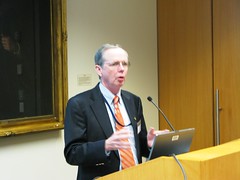
Ms. Derby introduced the four cornerstones of good governance: public officials; the governing body; internal auditors; and external auditors (SAIs). She concluded that the relationship between internal auditors and SAIs is both critical and beneficial to good governance and the effective use of public resources.
Ms. Derby described the evolution of audit standards, and the roles and responsibilities for internal audit and supreme audit institutions.
According to INTOSAI GOV 9100 (Guidelines for Internal Control Standards for the Public Sector), internal auditors examine and contribute to the ongoing effectiveness and efficiency of the internal control structure through their evaluations and recommendations and therefore play a significant role in effective internal control. Management often establishes an internal audit function as part of its internal control framework. In this tradition, the role of internal auditors is a critical part of an organization's internal control structure.
Ms. Derby introduced the benefits of coordination including:
- Strengthen mutual accountability
- Improved risk management
- More efficient audits
Risks of cooperation on audit standards include:
- Compromise on confidentiality
- Possible conflict of interest
- Use of different professional standards
Ms. Davis advocates the convergence of audit standards. She described the coordination and cooperation on these standards including:
- Communication of audit planning and audit strategy
- Collaborating on certain audit procedures, such as collecting audit evidence or testing data
- Communication of audit reports to each other
Ms. Davis suggested that internal and external auditors could use certain aspects of each other’s work to determine the nature, timing, and extent of audit procedures to be performed. She surveyed the audience to determine that there was not significant coordination between internal and external audit in most countries:
- 24% use each others work, 69% do not
- 18% share training programs 64% do not
- 34% share reports , 52% do not
- 37% work together on strategy, 41% do not
Ms. Davis advocated cooperation between internal and external audit throughout the entire audit lifecycle. She emphasized that assessment and communication should be documented in respective audit documents.








